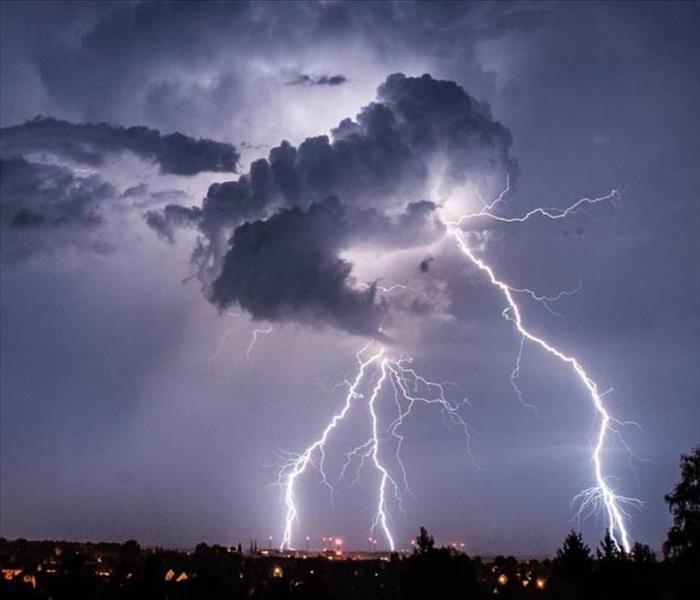Lightning Safety: What You Need to Know
5/13/2019 (Permalink)
The chances of being killed or injured by lightning are slim to none. However, that does not mean it can’t happen or that you should not exercise caution during a storm. The most important tip for being safe during a lightning strike is actually quite simple. Avoid being in the wrong place at the wrong time. Lightning is generated on a scale that is too large to be influenced by small objects on the ground, so if you are struck by lightning it is because you were in the spot that the lightning was already going to strike. Victims of lightning strikes in the past were struck regardless of the metal items that were or were not around them at the time.
Instead of thinking about the items that are around you, you would be better suited to focus on where you are. Avoid the areas where lightning can strike which is, essentially, anywhere outdoors.
Stay Indoors
Staying indoors during a storm is the number one way to keep safe from a lightning strike. If lightning strikes a house or a building directly, it will tend to follow the available paths to ground, including the electrical wiring, plumbing, cable or telephone lines, antennas and/or steel framework. Structures like bus shelters, outhouses, lean-to shelters, or any small non-metal structure do not provide any lightning protection. Although most homes serve as a safe shelter from lightning strikes there are still safety measures you can take inside to minimize danger such as:
- Don't use any wired appliance or device. Wireless appliances (cordless phones, razors, etc) are safe to use.
- Stay away from water pipes and faucets. (No baths, showers, etc.)
- Don't stand on a basement floor or patio slab, or anywhere where standing water or excessive moisture is present. These areas are 'ground current' danger zones.
- Stay away from walls where electrical wiring is present. Lightning will occasionally jump through the air inside a house or building to reach a better grounding path, such as from electrical wires to a water pipe.
Go to Your Car
If there is no other option for shelter, you are safer in your vehicle than out in the open. This is only true for hard-topped vehicles and does not apply to convertibles or open vehicles such as golf carts. While inside the vehicle keep your windows closed and make sure to avoid touching metal parts of the car. The current from a direct hit from a lightning strike will usually travel through the frame of the car and through the tires before hitting the ground. After a strike, make sure to check the vehicle to make sure fuel was not ignited which can lead to an explosion.
Does Clothing Matter?
Clothing and accessories you are wearing do not influence your chances of being struck by lightning. That being said, if you are struck, metal items you wear can act as conductors for the electrical current. These items can become vaporized, leaving burn marks on your body.
Lightning Warning Signs
In addition to the obvious warning of an ominously darkening sky, there are certain conditions that can alert you to a lightning danger before the strikes threaten. You are in a 'danger zone' and need to seek immediate shelter if you experience any of the following:
- Rain and hail can signal the presence of a thunderstorm cloud overhead especially if the rain is heavy. In fact, larger raindrops can occur when a thunderstorm cloud is tall and more likely to produce a lightning strike.
- If you can hear thunder or see flashes from lightning strikes, you are in the range of the next strike.
- AM Radio static, crackling, and popping noises can occur when lightning strikes are present.
- Doppler weather radar will show thunderstorms as red, orange and/or yellow blobs. There are many resources online that you can utilize to see this radar including mobile applications. The Weather Channel also shows Doppler radar periodically.





 24/7 Emergency Service
24/7 Emergency Service